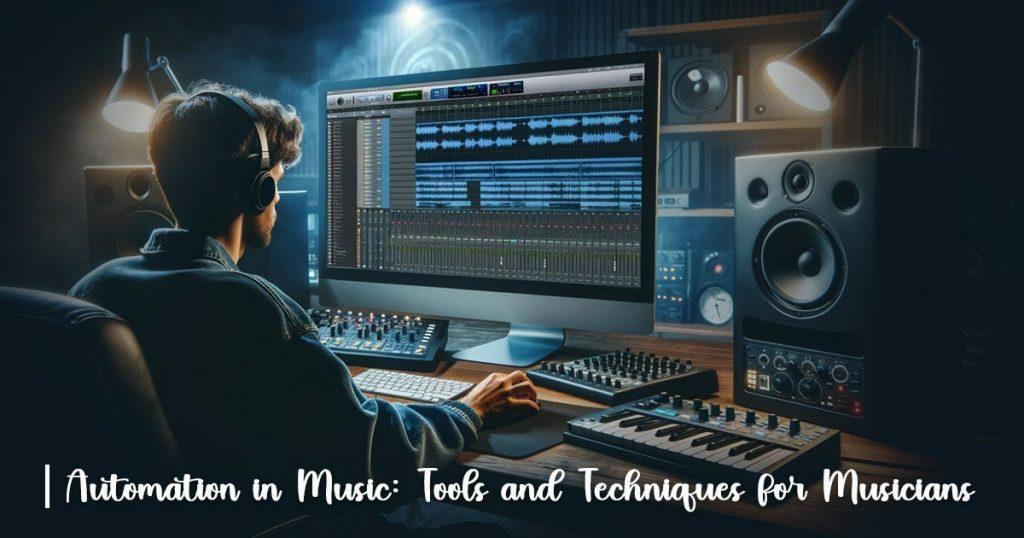Music is often called the universal language because it can bring out strong emotions and connect people from different cultures and generations. Many people love music because it naturally fits with our love for rhythm and melody. The music industry continues to do well, making $28.6 billion in 2023, showing that good music always finds its audience.
For musicians, creating music offers not just joy but also a way to make a living from something they love. This mix of art and work brings a lot of satisfaction as they produce music that others enjoy. However, making music isn’t easy—it takes a lot of time, effort, and skill to turn raw ideas into finished songs.
The Role of Automation in Music
If you love music but aren’t skilled in production, automation can be a game-changer for you. Music automation uses technology to control different parts of the music-making process over time, so you don’t have to do everything by hand. This helps producers fine-tune volume, panning, effects, and more, making their tracks sound better both creatively and technically.
What Can Music Automation Do?
Music automation can:
- Adjust Volume Levels: Automatically change the loudness of different tracks to make certain parts stand out.
- Pan Audio: Move sounds from left to right to create a sense of space and depth.
- Automate EQ Settings: Change the tone and presence of instruments or vocals at different moments in the song.
- Control Effects: Adjust reverb, delay, and other effects to add texture and expansiveness.
- Automate Plugin Parameters: Control specific settings in plugins for unique soundscapes.
- Manage Send Levels: Adjust the amount of signal sent to effect buses for changing intensities.
Music automation is a powerful tool that helps bring your music to life, making the production process smoother and your final product more polished.
How to Get Started with Music Automation: Steps to Automate Music
If you’re interested in trying music automation, here are some simple steps to help you get started. These steps will guide you through the basics and make it easy to understand.
1. Choose Your DAW (Digital Audio Workstation)
First, pick a DAW, which is software used for recording, editing, and producing music. Popular options include Ableton Live, Logic Pro, and FL Studio. For example, in Ableton Live, you can start your project using either the “Session View” or “Arrangement View.” Your choice of DAW will affect how easily you can automate different parts of your music.
2. Identify Parameters to Automate
Decide which parts of your track will benefit from automation. Common elements to automate include:
- Volume: How loud or soft a sound is.
- Panning: Moving sound from left to right speakers.
- EQ (Equalization): Adjusting the balance of different frequency ranges.
- Effects: Such as reverb (making sounds feel like they’re in a larger space) and delay (an echo effect).
For instance, you might want to automate the reverb on a vocal track to create a sense of space during the chorus.
3. Record Automation in Real-Time
Use your DAW to record automation by adjusting settings live as the track plays. This means changing things like volume or panning while the music is playing, and the software will remember these changes. For example, you can gradually increase the volume of a guitar solo by moving the fader (a slider used to adjust the level of a track) up and down while recording. Recording automation in real-time adds a natural feel to your music.
4. Draw Automation Curves
If you prefer precision, use tools like the pencil tool in your DAW to draw exact automation curves directly onto your tracks. An automation curve shows how a parameter changes over time. For example, in FL Studio, you can use the pencil tool to create a smooth curve for a filter sweep on a synthesizer track (a filter sweep is a gradual change in the frequency content of a sound).
5. Use Automation Lanes
Organize your automation data in separate lanes within your DAW for better control and clarity. An automation lane is a dedicated space where you can see and edit the changes you’ve made to a particular parameter. In Logic Pro, you can create one automation lane for panning and another for volume on your drum track. This keeps your project organized.
6. Experiment with Clip-Based Automation
Attach automation data directly to audio or MIDI clips to easily replicate automation across repeating sections. Audio clips are pieces of recorded sound, while MIDI clips are notes played by virtual instruments.
For instance, in Ableton Live, you can automate the filter cutoff (the point where frequencies start to be reduced) on a MIDI clip playing a bassline, then copy the clip throughout the song. This ensures consistency and saves time.
7. Refine and Iterate
Continuously listen back to your track and make adjustments to your automation settings. Fine-tuning means making small changes to get everything just right. For example, after automating the delay on a vocal track, listen to how it fits with other elements and adjust as needed. This ensures everything blends well together.
Following these steps will help you use automation to improve your music production. Experimenting with different settings and techniques allows you to create dynamic and engaging tracks.
Embrace Music Automation, but Trust Your Creative Instincts
Music automation is a great tool that can make your music production process smoother. It helps you adjust volume, panning, effects, and other elements to make your tracks sound polished and professional. But ultimately, how your music sounds is up to you.
Automation can help you bring your ideas to life, but your unique touch is what makes your music special. Whether it’s the melody, lyrics, or overall feel, your choices will shape the final result. So, while automation can assist you, trust your instincts and let your creativity shine through every note and word.
